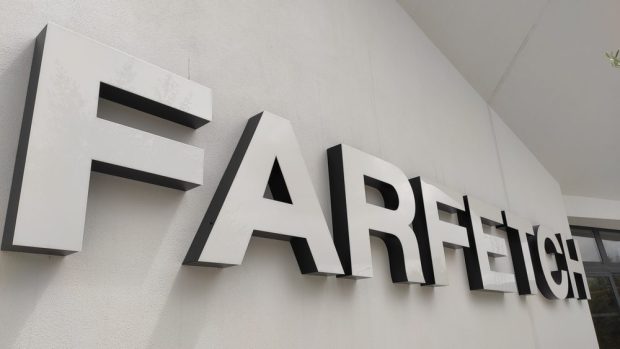Farfetch Aims to be at Center of Luxury Brands’ Shift to Digital

Luxury retail marketplace Farfetch is facing the same inventory and macroeconomic headwinds as other players in the sector but is pushing forward with plans to do more deals and further its mission to be the one-stop shop for high-end shoppers everywhere.
Like apparel retailers at all ends of the fashion spectrum, Farfetch lost some momentum in its fourth quarter as heavy promotions and excess inventory were cleared at deeper sale prices as it revealed during its Q4 2022 earnings call on Feb. 23.
“Our Q4 results reflect higher than expected GMV [gross merchandise value] from the marketplace, which was supported by strong supply growth from our luxury sellers,” Farfetch founder and CEO José Neves said as he also outlined an internal overhaul of the platform aimed at supporting growth in 2023 with the objective of achieving $10 billion in GMV within roughly 24 months, after already almost doubling since the start of the pandemic in 2020.
Other factors that also slowed Farfetch through 2022 into Q4 were its exit from trading in Russia and the late reopening of China, two large markets for the platform.
The digital marketplace that connects brands, boutiques and fashion suppliers worldwide with consumers overhauled its internal structure in 2022, creating the new role of chief marketplace officer “as a single point of accountability” and a chief fashion and merchandising officer to provide a unified view of the platform’s first party (1P) and third-party (3P) audiences.
Headwinds and Restructuring
However, headwinds in Q4 caused “a shift in the scheduling of some deliveries to our brand platform wholesale partners from Q4 2022 into Q1 2023,” along with “actions we’ve taken in Q4 to clear excess inventory levels through lower margin channels,” said CFO Elliot Jordan, who will retire at the end of 2023.
Jordan said Farfetch “is reducing inventory levels “on an absolute basis” and shortening terms on trade receivables to spur marketplaces growth and achieve more “favorable working capital dynamics.”
See also: Luxury Industry Digitization Drives YOOX Net-a-Porter, Farfetch Partnership
Farfetch Group President Stephanie Phair said 2022 was a challenging year. However, the platform was “still able to grow active customers by 6% whilst also driving a 7% reduction in demand generation spend thanks to our ongoing focus on brand building and efficiency in acquiring customers through diversified channels, specifically the Farfetch app, which is our most profitable and fastest growing channel and provides the direct means to reach consumers.”
Phair said, “Farfetch also helped brand partners clear through inventory in Q4 as we saw increased participation during our markdown window compared to the previous year.”
More Focus On First-Party Clients and Data
The increased focus on its first-party customer data is of increasing value to brands “especially in light of increased privacy restrictions that have reduced the ability to attribute marketing performance in the overall marketing landscape,” Phair said.
She said existing customer volumes on the marketplace grew double digits in almost every market excluding Russia and China year over year, adding that “Our private clients continue to be our crown jewel, demonstrating the resilience of the industry and we continued to expand this valuable consumer base in Q4 ahead of our overall consumer base.”
Illustrating how the platform is providing access to more high-value luxury customers, Phair noted efforts including support for Valentino’s fall-winter 22 Pink PP collection with shoppable content and early access for private clients which “drove incremental performance for Valentino with more than an 80% uplift in private client engagement and an average order value of approximately $2,500.”
See also: Farfetch to Pump Money and Punch Into Neiman Marcus and Bergdorf eCommerce Ops
Its arrangement with Ferragamo includes an exclusive spring-summer 2023 capsule on Farfetch, giving its members and customers “virtual backstage access during the runway show, incorporating responsive AI imagery thanks to our open innovation startup ecosystem. This was followed by a pre-order livestream and a series of private client-only events in Hong Kong, Brazil, London, and Dubai,” with 35 million impressions generated for the brand.
Phair said Ferragamo wished to capture a new and younger luxury customer “which Farfetch delivered. Over 80% of campaign traffic generated on the Farfetch marketplace came from new visitors to the brand, and approximately half of campaign clickers fell into the Gen Z and millennial cohorts.”
Responding to an analyst’s question on the 2023 outlook, Jordan noted forthcoming Reebok, Neiman Marcus Group and Ferragamo launches, saying “There is obviously, Reebok split between the brand platform and digital platform, the direct-to-consumer aspect of it going through the digital platform, Ferragamo, and of course the Neiman Marcus partnerships towards the back end of the year, so lots to look forward to in terms of new business that are joining the platform over the next 12 months.”
For all PYMNTS retail coverage, subscribe to the daily Retail Newsletter.

